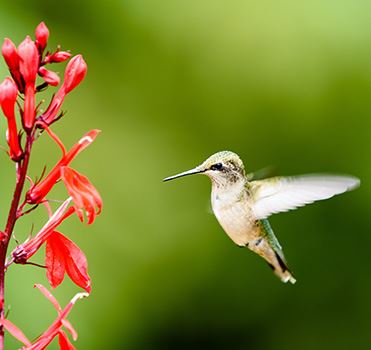Humming Along

Every spring, Ruby-throated hummingbirds make their long-distance migration back to northwest Ohio to take advantage of the abundant food sources and good nesting sites. Living in northwest Ohio, we are lucky enough to watch these beautiful birds as they dance at our backyard feeders and nest in our parks and other local natural areas. Weighing only 3 grams, they manage to make each flight back and forth from Ohio to Mexico and parts of Central America logging over 1,000 miles each way on their tiny wings. For flights of this magnitude, hummingbirds need to be well fit with enough energy reserves to successfully travel long distances. And, as we know, fitness starts with the right type of nutrition.
Ruby-throats are omnivores, as most of their diet comes from flower nectar, but some of it actually comes from insects and spiders they catch in mid-air near the blooms. When these birds start to return in April, insects and flower blooms may not be available readily, so placing a feeder in April can help provide needed energy. It should be filled with a solution of one part white sugar to four parts water. And, when the birds leave the area in September and into October, it is also important to make sure your feeder is full.
If placing feeders near a garden, consider planting some of the native blooms that are beneficial to hummingbird fitness. Preferred native blooming plants include: Spring: Wild Columbine, Smooth Penstemon; Summer: Butterfly Milkweed; Bergamot; Buttonbush; Late Summer: Cardinal Flower, Blue Lobelia, and Jewelweed. Metroparks grows many of these species from native, eco-type seeds and then adds them to local natural areas so that they can benefit wildlife like hummingbirds with the nutrition they need for nesting and long flights south. Seeds are collected in the wild or from a special propagation field and processed at the Blue Creek nursery. They are then grown in the greenhouse or directly sowed at a Metropark restoration site.
These birds also utilize native plants like the Cup plant and Sassafras in an interesting way---to drink water. The native Cup plant has tough, sandpapery leaves that clasp the thick, square stem making a cup. When it rains, the cup holds water for a hummingbird to drink! Sassafras trees serve the same purpose, but the waxy coated leaves hold robust droplets of dew for the hummingbird to consume early in the morning. All in all, hummingbirds need water, food and shelter to survive, and the native plants mentioned help to provide these things. Sustaining native plants in our natural areas is key for continued conservation.
Did You Know? Ruby-throated hummingbirds readily collect spider’s webs to bind their nests together. The elasticity of the silk allows the nest to expand as the young grows.